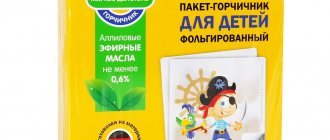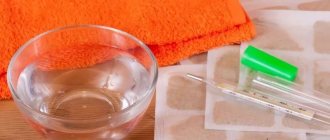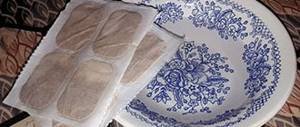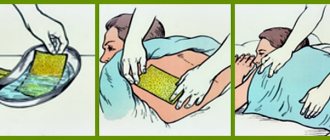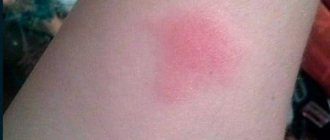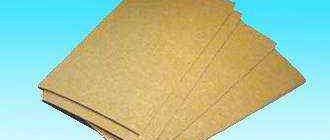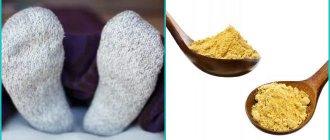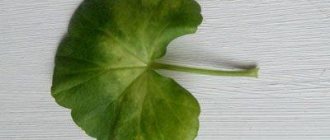Mustard plaster burn, what to do?
If you use mustard plasters for longer than the permitted time or with very sensitive skin, a burn may occur.
- Such a burn is chemical, and not thermal, as it might seem at first glance. The skin under the mustard plaster turns burgundy-brown, itching and peeling of the upper layer of the epidermis appear.
- The consequences of such a burn can be very serious. A patient who experiences such lesions requires emergency care. Mustard plasters must be removed quickly
- Wash the place where they come into contact with the skin (residues of mustard in the pores can further aggravate the problem), treat with an antiseptic and apply a sterile bandage. After which you should immediately consult a doctor
IMPORTANT: If a patient shows signs of allergic reactions when using mustard plasters, then he urgently needs to take antihistamines.
You need to wash the burn from mustard plasters with cool water. After which it is necessary to remove excess moisture from the affected area. To do this, use a sterile napkin.
Fat or oil should not be used to relieve pain.
The film formed by these products can slow down the healing process of the wound.
Such a burn must be treated with an antiseptic drug that has a calming effect. These drugs include: miramistin, furacilin or syntomycin ointment. After applying this product to the wound, it needs to be bandaged.
With proper assistance, the burn from mustard plasters will go away in 2 weeks.
What are mustard plasters?
The usual therapeutic agent is a thick, deterioration-resistant sheet of paper; the inside is covered with mustard powder. Sometimes this is a paper bag with dry contents inside. This folk medicine acts in 3 ways:
Local irritating function. It consists of stimulating skin cells, and underneath them, nerve endings and blood vessels. This leads to the acceleration of biological processes and the approach of recovery.
The second function is warming. Both pharmacy and homemade mustard plasters have a warming property. They lead to a slight increase in tissue temperature. This effect is important for hypothermia, some problems with ligaments and muscles.
Distractive property. A folk remedy temporarily relieves pain. This is explained by the effect on the nervous system, but sometimes there is a placebo effect. The patient cannot or does not want to use more effective therapeutic methods, but uses mustard plasters, subconsciously giving an indication that recovery is approaching.
A special feature of this method is mustard essential oil. Upon contact with wet skin, during profuse sweating, or when water is applied to the surface of the mustard plaster (they are moistened), essential oils begin to act actively.
They have bactericidal and antiseptic properties. The aroma oil of this plant also has an anti-edematous effect.
The advantage of the traditional method of treatment remains low cost and availability. This is explained by the wide distribution of the main component for the production of powder - seeds of Sarepta, or black, Russian mustard.
It grows in cultivated and wild form in the northern regions of Russia and Central Asia, in some countries of Europe and Africa.
The same powder is widely used in cooking, aromatherapy, and cosmetology. It has been used since ancient times and is recognized as effective in folk and official medicine.
How do mustard plasters affect?
The product consists of a small sheet, divided into several equal parts, inside which the powder is located. Before applying it to the required area, it is recommended to lower it for 15 minutes and hold it in water, the temperature of which should be between 38-40 degrees. During this process, essential oils are released that have a disinfecting effect. They block the inflammatory process and reduce the activation of pathogenic microorganisms. This product also has an irritating and distracting effect.
As soon as the leaf with the contents comes into contact with the skin, irritation occurs. The skin in this area turns red. Thanks to this effect, metabolic processes are enhanced, inflammation and pain are relieved.
In addition, aromatic oils, when released, affect certain endings located on the skin and provoke the sympathetic nervous system. As a result, adrenaline and norepinephrine are released, provoking the activation of phagocytosis processes in the human body. As a result, recovery occurs much faster.
All about mustard
One of the most famous and effective procedures with mustard, applicable at home.
| Disease | Reason for development | Specific symptoms |
| Pharyngitis | It occurs as a result of prolonged irritation of the pharyngeal mucosa by alcoholic beverages, chemical reagents, and as a result of infection of the upper respiratory tract. | Patients with this diagnosis complain of the following symptoms: persistent pain and burning in the throat, painful dry cough. Upon visual examination of the oropharynx, the doctor detects redness of the tonsils. |
| Tonsillitis | Develops against the background of prolonged inflammation of the tonsil glands after a sore throat, infectious diseases (scarlet fever, measles, diphtheria). | The symptoms of this disease are mild and the clinical picture is visible only with pharyngoscopy: the tonsil glands are enlarged, a gray coating is present. With tonsillitis, there is unstable pain in the oropharynx. It worsens in the autumn-winter period during hypothermia of the body. |
| Laryngitis | Pathology of the vocal cords and inner lining of the larynx is a consequence of overstrain of the upper respiratory tract, exposure to tobacco products, and allergies. The most common causative agent of this disease is infectious microorganisms. Singers and teachers are most susceptible to the chronic form of laryngitis. | Doctors diagnose constant swelling of the larynx, which easily becomes inflamed with mild colds, eating spicy foods, or straining the vocal cords. As a result, patients' voice timbre changes. Nodules form on the surface of the larynx, interfering with the natural functioning of the vocal cords. As a result, the patient develops hoarseness. In severe forms of damage to the larynx, the voice may disappear altogether. |
| Sinusitis | The disease occurs in situations where doctors diagnose an inflammatory lesion of the paranasal sinuses. With this disease, the infection can spread rapidly and provoke complications such as otitis media and meningitis. | Damage to the paranasal sinuses is accompanied by the release of viscous mucus, which flows down the back wall of the oropharynx and further irritates it. As a result, patients constantly cough, complain that it is painful to swallow and a feeling of non-stop soreness in the throat. |
The magical properties of mustard do not end with mustard plasters alone.
Mustard plasters at a temperature are a dangerous treatment
It is well known that it is not recommended to use mustard plasters at temperatures. When used correctly, mustard plasters have a local irritant, anti-inflammatory, and analgesic effect. When mustard plaster is wetted with warm water, a chemical reaction occurs between the substances that make up the mustard powder applied to the surface of this medicinal product. As a result, an essential oil is released that interacts with the nerve endings of the skin.
The main medicinal property of mustard plasters is the irritating factor, which results in increased blood circulation on the skin and accelerated metabolic and regenerative processes. It is believed that exposure to mustard plasters most effectively promotes the formation of biologically active substances that effectively help overcome the negative effects of infection.
At elevated temperatures, protective reactions are activated in the human body, so mustard plasters should not be used at body temperatures exceeding 37°. Typically, mustard plasters are used for diseases of the respiratory system, such as laryngitis, tracheitis, bronchitis, pneumonia, but only after the end of the inflammatory process.
Moreover, the scope of their use is much wider. For knowledgeable, experienced people, mustard plasters are an effective weapon in overcoming an attack of so-called “angina pectoris,” or, scientifically speaking, angina pectoris. Mustard plasters help get rid of migraines. This simple remedy can restore performance in case of radiculitis.
Mustard plasters remarkably relieve spasms of any origin, cope with kidney, liver, and intestinal colic.
You should know that mustard plasters should not be used when the temperature has risen due to inflammation of the skin. It is very dangerous to use mustard plasters if there is hemoptysis.
It is not advisable to use this drug in the presence of cancer, regardless of body temperature.
The danger of using mustard plasters at elevated body temperatures is that the load on the heart muscle and lungs seriously increases. Mustard plasters can be used for the healing process only after taking antipyretic medications.
When body temperature levels stabilize, mustard plasters will be able to effectively perform their main function. Mustard plasters will not help if the temperature rises during an acute respiratory viral infection, but on the contrary, will significantly increase the healing time.
The patient will begin to experience severe weakness, and possible unpleasant pain behind the sternum.
At elevated temperatures, the use of mustard powder as a warming agent is prohibited, not only in the form of mustard plasters.
It is not recommended to soak your feet with mustard while wrapping yourself in a warm blanket and drinking hot liquids, including milk or special medicinal hot drinks.
Almost all thermal procedures at elevated body temperatures are strictly prohibited. Also, it is strictly forbidden to place mustard plasters on the lower back, spine area, or heart area.
As a rule, people put on mustard plasters and stoically endure the pain. The result is red rectangles of burned skin. This happens especially often in young children. In young children, the skin is extremely susceptible to this type of irritant.
If you need to put mustard plasters on a very small child, you should use a layer of wide bandage as a separator between the skin and the burning surface of the mustard plasters. This also applies to some modern mustard plasters, for which the thinnest paper is sometimes used.
Therefore, putting mustard plasters at temperatures is extremely dangerous, both for adults and children.
Unwise use of this simple remedy at elevated temperatures, especially when treating young children, can lead to burn shock with all the ensuing negative consequences.
If the body temperature of a sick person has returned to normal, applying mustard plasters at night, subject to all precautions, will help recovery as soon as possible. Good health to you!
Indications for use. For what diseases?
When planning to apply mustard plasters at a temperature, they usually do not think about their versatility, although this method of home therapy affects the entire body.
Patches are applied during certain inflammatory and colds, and for pathologies of the nervous, muscular and cardiovascular systems. Source: nasmorkam.net Most people become familiar with this remedy in childhood, when parents administer it to their children for acute respiratory infections. But the list of applications is much wider:
1
Inflammation of the nasal mucosa, mucous tissue of the peripharyngeal ring. At the same time, avoid using the product on a specific focus of the disease. In the case of these signs, mustard plasters are placed on the back of the neck, on the feet - there are many biologically active points there that affect the entire body.
2
For inflammation of the trachea, if the doctor allows, apply to the upper chest, but not to the heart.
3
For tachycardia, angina pectoris, and hypertensive crisis, medical workers can use folk medicine for external use. It improves heart function, normalizes rhythm and blood pressure. Place on the calf muscles, back and chest areas, avoiding direct application to the heart area.
4
For diseases of the peripheral nervous system, when it is necessary to restore sensitivity and motor function of nerve endings. This often occurs with neuralgia. Apply directly to the affected area.
5
For inflammatory processes in muscle tissue - myositis: for radiculitis, sprains.
Important!
All these situations can be associated with changes in the thermal state of the body, so the temperature for placing mustard plasters, as indicated by the presence of contraindications, plays a major role.
Knowing these features, remember the rules of treatment with folk remedies. Take mustard plasters, immerse them in warm, but not hot water for 5 - 10 seconds, and then take them out. Then apply directly to the skin.
If it is sensitive, it is covered with gauze, and only then mustard plasters are laid out. A layer of fabric should be placed on top of them to ensure a warming and penetrating effect. You can take a towel, scarf, blanket.
Remember
It is recommended to keep the product for 5 to 15 minutes (you cannot leave wet patches overnight); if discomfort or burning occurs, remove it.
The skin, at the request of the patient, is lubricated with nourishing cream or oil, since mustard powder has an irritating and drying effect.
For colds, the course of treatment lasts 5-6 days, for neuralgia, myositis - until improvement, sometimes this auxiliary therapy is one-time.
Why are mustard plasters needed and how do they work?
The main purpose of mustard plasters is to force the body to heal itself. The action is based on a rush of blood to problem areas, as a result of which pain symptoms are relieved and inflammatory processes are damped. The work algorithm is based on the physiology of the human body:
- blood vessels dilate under the influence of an external stimulus;
- blood circulation increases;
- in parallel, the excitability of the sympathetic nervous system increases, which gives an influx of adrenaline into the blood;
- adrenaline enhances the phagocytic reaction - the main factor of immunity in the fight against infections and inflammation.
Using mustard plasters, we force our body to react faster to the disease, boost the immune system and bring recovery closer, using only internal strength. Therefore, it is extremely important to carry out the procedure correctly, taking into account the indications and only in the absence of other strong stresses (high temperature, especially in children; external and internal bleeding, etc.).
Indications for placing mustard plasters:
- respiratory diseases;
- headache;
- heart pain (distracting effect in the chest area);
- high blood pressure;
- muscle pain.
Indications for use of the drug include cough, headache, sprains, and bruises. It is important to remember that mustard plasters must be used strictly for their intended purpose. Attempts to fight cellulite with their help (there are such bad tips!) can end tragically not only for cellulite, but also for health.
In our country, the drug is available in two forms:
- a thick sheet of paper (8 x 12.5 cm) coated with a mixture of mustard cake and seeds;
- paper bags of 3 g each, in which the mustard mixture is divided into 4 sections by gluing seams.
Before use, be sure to check the expiration date of the drug. Expired mustard plasters change color, and the mustard mixture may dry out and crumble.
Contraindications for mustard plasters therapy
When mustard plasters are used incorrectly, complications and side effects occur, for example:
- allergy;
- subcutaneous hemorrhages;
- chemical burns;
- emotional distress in children due to a reaction to an unpleasant procedure.
Contraindications:
- special sensitivity to mustard powder: acute burning at the site of application of mustard plaster, allergy;
- any dermatological disease (pustular pathologies, fungal diseases, dermatitis) in the area of application;
- elevated temperature;
- malignant tumors;
- lung bleeding.
Before using mustard plasters, you should consult a specialist to check for any allergic reactions or contraindications. If mustard plasters for coughs are administered incorrectly to children and the expiration date is not checked, such treatment will be detrimental to health.
It is difficult to find an adult who has never been treated with mustard plasters. Previously, they were produced only in the form of thick sheets of paper, on one side of which a layer of mustard powder was applied. Now in the pharmacy chain you can find original mustard plasters in the form of bags of dry mustard powder. The effect of all mustard compresses is identical. This remedy is used mainly for colds, although neuralgia is also indicated. Doctors are often asked a logical question: is it possible to apply mustard plasters at a temperature? The concern of patients is absolutely understandable. After all, a cold often occurs against a background of high body temperature.
How to install mustard plasters
Despite the fact that mustard plasters have been used for a very long time, not everyone knows exactly how to install them correctly. Because of this, there are often cases when mustard plasters do not bring the expected result. The correct procedure for using mustard plasters is as follows:
- immediately before application, mustard plaster is moistened for 5 seconds in water at a temperature of 50 degrees;
- The mustard plaster is carefully placed on the selected area and smoothed to evenly distribute the mustard powder;
- after all the mustard plasters have been placed, the patient is wrapped in a terry towel;
- for the duration of exposure to mustard plasters, the patient is put to bed and covered with a warm blanket;
- after removing mustard plasters, wipe the skin with a damp towel and rich cream;
- The patient is placed under a blanket and must rest for at least 2 hours.
Is it possible to put mustard plasters on a child for bronchitis?
Inflammation of the bronchial tree has three forms: chronic, acute and obstructive. In case of a chronic, residual phenomenon that is not accompanied by elevated temperature, children from 1 to 3 years old are already allowed to apply patches.
It is better - if on the feet, on the back or chest - one by one, every other day for 5 days. The time for such small patients should not exceed 2 - 3 minutes. But it is difficult to explain the benefits of this treatment method to children under 10 years of age. It causes a burning sensation, a desire to get rid of the source of discomfort.
In acute bronchitis, which is caused by a bacterial or viral infection and is accompanied by chills and fever, they are not given.
In case of obstructive bronchitis, when thick mucus has accumulated in the bronchi and is difficult to separate, mustard patches can be applied, but strictly after consultation with a doctor.
Important! Sometimes the obstructive form of the disease is caused by allergens, dust, and excessive heating can be harmful.
Where can you put mustard plasters for children?
For bronchitis or pneumonia, place mustard plasters on the back, for laryngitis - on the front surface of the neck, for tracheitis - on the front of the chest, for angina - on the heart area, for hypertension - on the calves of the legs, for cervical radiculitis - on the back of the neck, for lumbar for radiculitis and renal colic - on the lower back, for headaches - on the back of the head, and for intestinal colic - around the navel.
Take one mustard plaster at a time and place them in water. Let them get thoroughly wet. Place the side covered with mustard on the skin, the distance between the mustard plasters is 1-1.5 cm. Cover them on top with a towel, and to keep warm longer, also with a blanket. Good mustard plasters will definitely burn. Have your patient be patient and hold on for 10-15 minutes.
When removing mustard plasters, pay attention to whether the skin turns red - this is a kind of indicator of the effectiveness of the procedure. Wipe the skin with a damp, wrung-out sponge and towel, while making massaging rotational movements. Put the patient to bed, covering him warmly with a blanket.
Home physiotherapy using mustard
The medicinal use of mustard is not limited to banal mustard plasters. Here are just the most effective mustard procedures that can be used at home.
Mustard wraps. First prepare the mustard solution. Place two tablespoons of mustard in a gauze bag and place in hot forty-degree water. Soak a large piece of cloth or diaper in the prepared solution and wring it out.
Then quickly wrap the patient's back and chest, smoothing out the wrinkles. Cover the patient with a sheet and blanket and leave for five minutes.
After the procedure, you need to quickly rinse in a warm shower, rub yourself thoroughly with a warm terry towel, put on warm underwear and slip into bed.
General mustard bath. Fill the bath. The water temperature should be 37°C. Dissolve mustard powder in it at the rate of 50 grams of powder per 10 liters of water. Place the patient in the bath so that the water reaches the heart area. The duration of the procedure is 5 minutes. Then you need to do the same as after the mustard wrap.
Mustard foot bath. In a ten-liter basin (water temperature - 38 ° C) dilute 100 grams of dry mustard powder. When the patient lowers his legs into the basin, cover them with a blanket. The local bath is quite safe, so you can steam your feet for 20 or 30 minutes. After the bath you should wear warm socks.
Mustard compress. This warming procedure is used for local inflammation of the lymph nodes, muscles and ears, as well as for bruises. However, remember that the compress is prescribed only after the acute phenomena have subsided.
Dilute a teaspoon of dry mustard in one liter of water (temperature 37°C). Soak gauze folded in six to eight layers in this solution and squeeze out.
Place the gauze on the sore spot and cover it with a sheet of compress paper or cellophane so that the edges of the gauze are covered. Place a thick layer of cotton wool on the insulating layer, secure the compress with a bandage and leave overnight.
In the morning, after removing the compress, wipe the skin first with a warm, damp towel and then with a dry one. It would be good to put warmed cotton wool and hold it for another hour.
Is it possible to put mustard plasters on the throat for a cold?
For colds and respiratory diseases characterized by inflammation of the larynx, hoarse voice, and pain, mustard-based patches are widely used. For laryngitis, laryngotracheitis, tonsillitis without fever, they are effective.
They are used for both dry and wet coughs. Patches soaked in warm water are placed on the skin.
Important! The skin of the cervical area is sensitive and easily susceptible to heat. To avoid harm, you can apply them to the throat, front and back, dry, but wrapped in a towel or a warm scarf. You can stay like this for 30 – 60 minutes, after which the mustard compress is removed.
Mechanism of action of the drug
Despite the fact that in recent years the question of the benefits of mustard plasters has been called into question by official medicine, many years of experience in their use says the opposite. This affordable and cheap remedy has become firmly established in the practice of home treatment for a number of diseases.
The mechanism of action of mustard plasters has been well studied and is as follows. Mustard oil, which is part of their composition, and other essential oils are intensely released when interacting with water and have the following effect on the skin:
- Irritate sensitive nerve endings, causing a burning sensation, this leads to a reduction in pain;
- They irritate the receptors of the autonomic nerves, as a result the blood vessels dilate, and the flow of blood to the skin and overlying tissues at the site of application increases;
- Blood flow to the diseased area increases tissue immunity and reduces inflammation;
- Increased blood circulation causes a feeling of warmth, body temperature rises;
- Essential oils are phytoncides that inhibit the development of microbes.
The use of mustard plasters for various diseases is based on these properties.
When you need to increase blood circulation, relieve pain, or warm up, they are placed directly over the diseased area of the body. On the contrary, if you need to reduce swelling or create peace during acute inflammation, they are placed in a distant area for a distracting effect. Only with a reasonable approach mustard plasters will be beneficial.
Negative reactions of the body and contraindications to the procedure
Before you start applying mustard plasters or cupping, you need to make sure that there are no contraindications to these procedures - then the likelihood of causing additional damage to the body will be minimal.
There is a risk of an allergic reaction.
The list of restrictions that make it impossible to use mustard plasters includes the following conditions:
- If the general body temperature is elevated and it is strictly forbidden to apply mustard plasters for another day after the temperature has returned to normal.
- Symptomatic manifestations of increased bleeding.
- Diseases of the skin, especially the use of mustard plasters is unacceptable on open wound surfaces, as well as lesions with purulent contents on the skin.
- Pulmonary tuberculosis, as well as spinal tuberculosis.
- Increased risk of seizures.
- Pathological processes that are characterized by an oncological nature.
- Pregnancy, regardless of trimester, as well as the period of breastfeeding.
- State of mental overexcitation.
Also, it is undesirable to use mustard plasters when the patient’s age is less than 12 months, as well as in the presence of active allergies, bronchial asthma and psoriasis. Also, it is necessary to take into account that mustard plasters for patients under 3 years of age can be placed exclusively with the passive side to the skin or through a backing made of natural material - this can be a bandage or a dry thin fabric or thick paper napkin.
Mustard plasters are not placed on top of ulcers, cuts and other violations of the integrity of the skin. Also, it is contraindicated to use the product if you have a severe allergic reaction to mustard and its derivatives. It should be understood that the use of this drug is allowed only after consultation with a treating specialist (especially for patients in the pediatric age category), as well as when body temperature is stable.
Features of treatment for children
The use of mustard plasters in the treatment of children has always caused a lot of controversy. Some doctors are categorically against such treatment of young patients, others recommend such treatment, but only in compliance with certain rules.
Young children should not place mustard plasters directly on the skin, as it is too tender and there is a high risk of burns. Children are given such compresses only through a layer of thin cotton cloth or gauze. As an option, place the sheets with the back side. The duration of the warming procedure in children should not be more than 3 minutes.
Sometimes parents give mustard applications to their children at a temperature of 37 degrees, believing that at this temperature there will be no harm. But it is worth considering that some children already have convulsions at a body temperature of 37.5 degrees. That is why it is strictly forbidden to put mustard plasters on a child when he has a fever. Even if she is just low-grade fever. You need to understand that any warming procedures at this time can cause a sharp rise in temperature and it will be very difficult to bring it down. You can put mustard plasters on your baby at a time when the body temperature is normalized under the influence of antipyretics.
When treating a child with mustard plasters, you need to carefully monitor his condition. If the baby feels any discomfort, the procedure is stopped.
Sequencing
The algorithm of actions is quite simple. Before you start, make sure you have:
- fresh mustard plasters in the right quantity;
- warm water up to 40°C (water temperature above 45°C destroys mustard essential oils - the main irritants, negating the entire therapeutic effect);
- a towel, gauze wipes, a thin diaper for babies and heated vegetable oil (to prevent burns).
To begin with, the patient must be comfortably positioned in such a way that the part of the body on which the placement will be performed according to the indications is open. Then we act, strictly adhering to the algorithm.
Technique for setting mustard plasters:
- After completion, the area should be wiped clean of mustard residues (for children, remove any remaining oil). This is done with a clean napkin soaked in warm water, with careful movements, trying not to press too hard on the insertion sites (to avoid unpleasant sensations).
- If the patient is in normal condition, the duration of the session is up to 15 minutes. But after 5-10 minutes. there will be an effect, so you shouldn’t mock the patient too much and force him to withstand the entire 15 minutes.
- This point is very important! Allow time (3-5 minutes) and check the patient. If you experience a strong burning sensation, you need to check the area for redness. If hyperemia occurs (overflow of blood vessels, expressed in redness of the skin area), stop the session immediately. You need to listen especially carefully to children. They cannot always explain what is bothering them; they should check the placement sites regularly (perhaps even before 3 minutes if the child is restless).
- Cover the installation site with clean paper or film and wrap it with a towel on top. This is necessary so that the mustard mixture warms up to 39-45°C; it is at this temperature that the release of essential oil begins.
- Apply the prepared sheet with the side covered with the composition to the body in a predetermined place (see diagram of indications and location of mustard plasters).
- Dip the mustard plaster into a container of water for 1-3 seconds. If the drug is made in the form of a paper bag, it must be shaken before immersing in water so that the powder is evenly distributed throughout the cells.
- Carefully examine the patient for damage, scratches, wounds or moles at the site of intended placement. For young children, it would be a good idea to lubricate the placement area with heated vegetable oil to prevent burns.
- Gently wipe the place of placement, help the person lie down more comfortably and leave him to rest for 30-40 minutes. The thermal procedure puts a lot of stress on the body, so you need time to recuperate (at least 20 minutes, but 40 is better).
If the exposure time is not calculated, redness or burns may occur. They should be washed carefully and lubricated with emollient cream. In order to reduce the risk of burns, people with sensitive skin and children can place mustard plasters on gauze folded in half and moistened with warm water.
Mustard plaster on the neck for tracheitis
The main causes of cough are tracheitis, pharyngitis, laryngitis and of course bronchitis
If the cough is accompanied by pain in the chest area, then most likely it is caused by tracheitis. To treat such a cough, mustard plasters should be placed on the chest. But, it is necessary to exclude their projection onto the heart area.
Mustard plasters for the treatment of such a cough are placed in the amount of two pieces on the chest along a vertical line. Usage time: 5-15 minutes.
Laryngitis and tracheitis (inflammation of the larynx with vocal cords or trachea) often accompany each other.
For laryngitis and tracheitis, mustard plasters are placed under the collarbones.
They are unpleasant not only for their symptoms, but also because they can very quickly develop into bronchitis or pneumonia. Many people think that for these diseases it is necessary to put mustard plasters on the neck. This is wrong!
For laryngitis and tracheitis, the essence of the procedure is to draw blood away from the inflamed organs. Therefore, mustard plasters are applied to the area below the collarbones or calf muscles.
Placing mustard plasters on pregnant women at fever
Whether mustard plasters can be placed during pregnancy or not, experts also cannot answer unequivocally. Some argue that the procedure can be performed if the woman does not have the following diseases:
- bronchial asthma;
- purulent skin infections;
- oncological nature;
- individual intolerance.
But even in the absence of these pathologies, it is recommended to place them on the calves for a short time or make foot baths with them and, of course, at normal body temperature.
Other experts believe that it is impossible to use mustard plasters even without fever, explaining their position as follows:
- their use provokes an increase in pressure, and this in turn causes a narrowing of blood vessels localized in the uterus, as a result the fetus does not receive enough oxygen and nutrients, which negatively affects its development;
- the substances contained in mustard have an abortifacient effect;
- when placing mustard plasters, blood tends to the place of their influence, as a result, its outflow from the uterus is observed, which provokes fetal hypoxia;
- any heating of the limbs, pelvis, abdomen, chest and back causes activity of the uterus, and this in turn increases the risk of spontaneous abortion.
That is why you should not use mustard plasters during pregnancy, even if the temperature is normal, and even more so you should avoid them when it is elevated.
Today, there are many products that can be used to replace them, and they will not have a negative effect on the woman’s body or the fetus.
It can be said that mustard plasters can be given to adult patients after consultation with a specialist if they have a temperature no higher than 37 degrees. They can be used in children at normal body temperature, but in pregnant women it is better not to carry out the procedure.
Did the article help you?
Let us know about it - rate it
Loading…
After mustard plasters the temperature rose: what to do?
The phenomenon when, after mustard therapy, the temperature on the thermometer rises sharply is dangerous. Sometimes this indicates an increase in the load on the heart, a worsening of the disease, and the spread of infection further through the organs of the respiratory system. [ads-pc-1][ads-mob-1] If during treatment they did not take into account at what body temperature it is allowed to use mustard patches, and they harmed the body, the temperature rose above 38.5 degrees and is rising, antipyretic drugs are used - based on paracetamol (Panadol is often included in the list of required home medications) or ibuprofen (Nurofen is often used in tablets and syrup form).
They do this according to age and body weight, having first studied the instructions. It is not recommended to reduce the temperature to 38.5 with medications.
Contraindications
Each product has a list of diseases and conditions for which its use is prohibited. Patches based on mustard powder should absolutely not be used in case of skin pathologies, irritations: in the case of dermatitis, neurodermatitis, boils, open wounds, ulcers, cuts, burns.
They refuse the folk remedy if there are moles, papillomas, or warts in the place recommended for applying the patch.
Other conditions are also contraindications:
- The presence of a cough accompanied by fever, pronounced bacterial or viral infections. Then warming the body with mustard patches is dangerous. It leads to the rapid spread of infection throughout the body, and the immune system will not have time to form a protective reaction.
- For cancerous and benign tumors. Warming with mustard plasters leads to a worsening of the patient's condition.
- During pregnancy and breastfeeding. Heating the abdomen and back can cause bleeding, and during lactation, mustard aroma oil penetrates into breast milk and can negatively affect the condition of the mammary glands.
- In case of an allergic reaction to the contents of the patch.
Also, mustard plasters should not be placed at (high) temperatures. You will also have to refuse treatment in case of low skin sensitivity. Some people may not feel the burning effect of mustard powder, but redness remains on the epidermis, as if from burns.
Is it possible to put mustard plasters on pneumonia?
If it is allowed to make mustard plasters at temperatures during pneumonia, then at low temperatures - up to 37 degrees. But doctors often advise against such self-medication altogether.
Pneumonia is a disease of predominantly infectious (viral, fungal, bacterial) origin. It is sometimes accompanied by fever, a feeling of tightness in the chest, and wheezing.
Mustard patches can cause additional heating of already inflamed lung tissue or alveoli, causing serious disorders and worsening the patient’s condition.
Important! With pneumonia, mucus sometimes accumulates in the alveolar cells, which needs to be released. The use of warming techniques, including inhalation, foot treatment, and hot baths, is permitted only after the recommendations of a doctor.
Contraindications for use
The first thing you should be interested in in any drug is contraindications. This rule also applies to mustard plasters. So, contraindications for staging:
- Age. Children can only undergo the procedure from the age of six!
- Heat. For adults – above 38°C, for children – above 37°C. In the acute phase of the disease, the use of warming procedures is contraindicated; you should wait until the patient’s condition improves and the temperature decreases.
- Any bleeding. External wounds or internal bleeding weaken the body; placing mustard plasters in such a situation can be harmful.
- Some diseases: malignant tumors, active form of tuberculosis, asthma, blood diseases.
- Problems or damage to the skin (neurodermatitis, psoriasis, eczema), moles or birthmarks at the intended location.
- Skin sensitivity or allergy to mustard.
- During pregnancy, mustard plasters can only be used with the permission of a doctor!
It is dangerous not to pay attention to any of the listed contraindications. Instead of the expected relief, this can cause serious harm to the patient. In addition, mustard plasters should not be placed on the mammary glands or face. For children, it is best to conduct the session in the evening, so that before going to bed there is time to cough up the mucus that comes out.
Mustard plasters during pregnancy
Unfortunately, viral diseases can trap a woman at that stage of life when she is preparing to become a mother. Moreover, it is during this period that her body is most vulnerable. And therefore, colds and ARVI are not uncommon.
During pregnancy, many drugs that we use in “normal” life cannot be used. Mustard plasters are also among them. They have a clear warming effect, which can be very harmful during pregnancy. Moreover, using mustard can lead to miscarriage.
Mustard plasters, as well as foot baths and other similar procedures, can increase the activity of the uterus
- What can lead to abortion or premature birth
- It is especially dangerous to use mustard plasters in the first trimester of pregnancy. At a time when the child’s body is just forming
- During pregnancy, mustard plasters can be replaced with inhalations. Using potato vapors, some herbal remedies, calendula, eucalyptus, chamomile and St. John's wort, you can clear the bronchi and nasopharynx of mucus and bacteria. You can also choose essential oils for this purpose: fir, pine
During pregnancy, women's immunity often decreases, so expectant mothers are at risk for ARVI and other diseases. And since they cannot take most medications, they are often treated with auxiliary and folk methods.
Pregnancy is a contraindication for the application of mustard plasters.
But they absolutely cannot treat a cough, runny nose or headache with mustard plasters.
During the procedure, a significant increase in uterine tone is possible, accompanied by fetal hypoxia. In the early stages there is a high probability of miscarriage, in later stages - premature birth.
